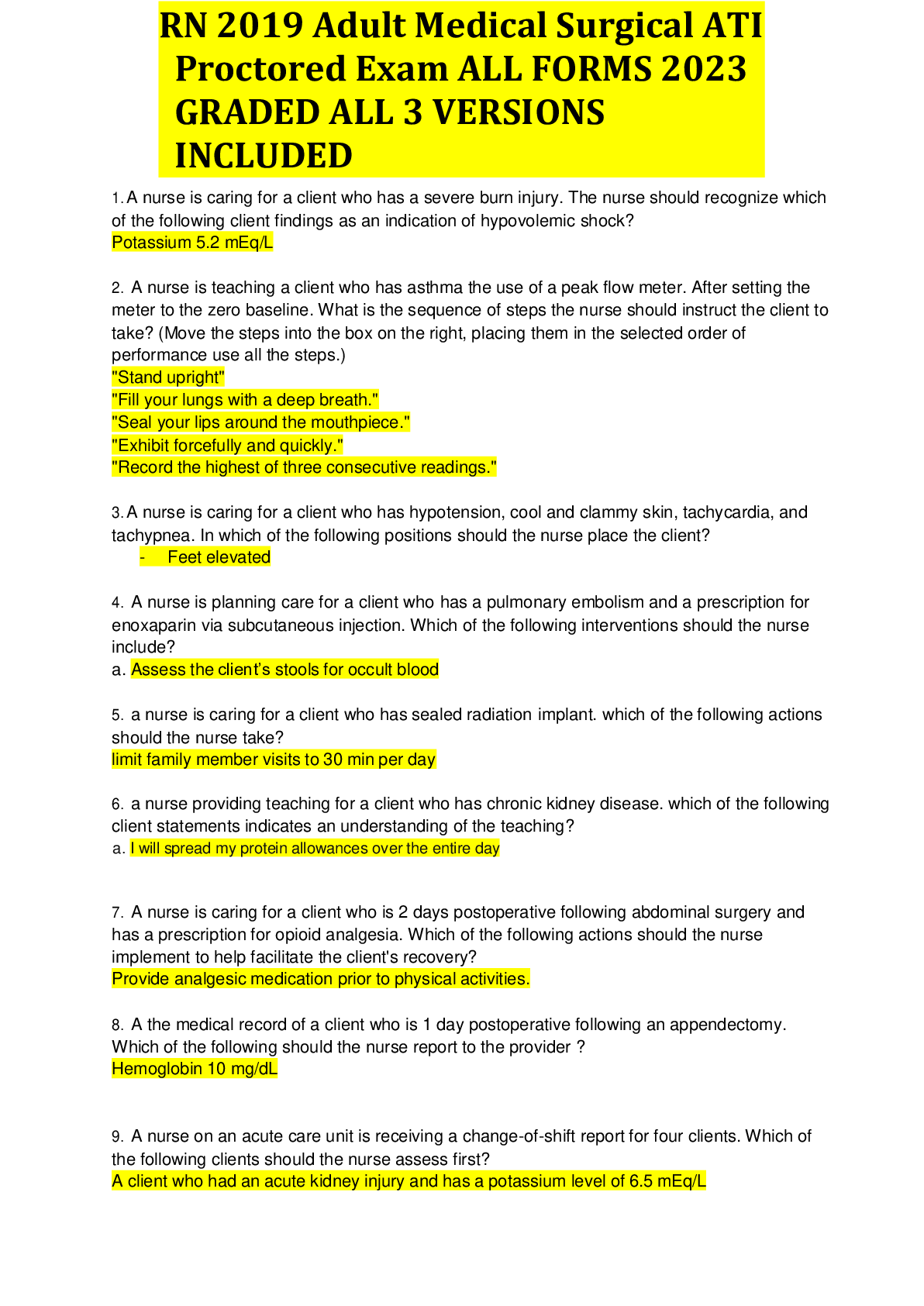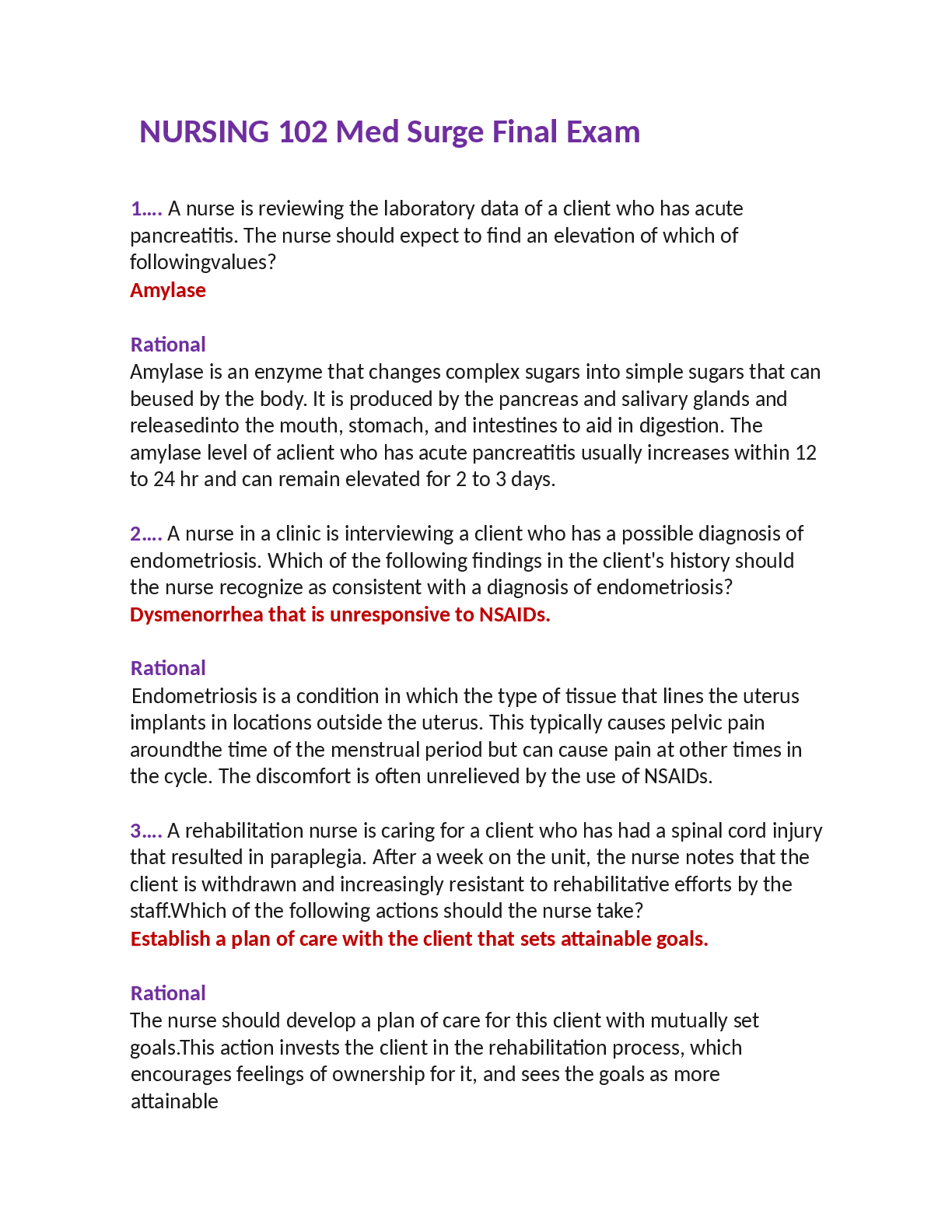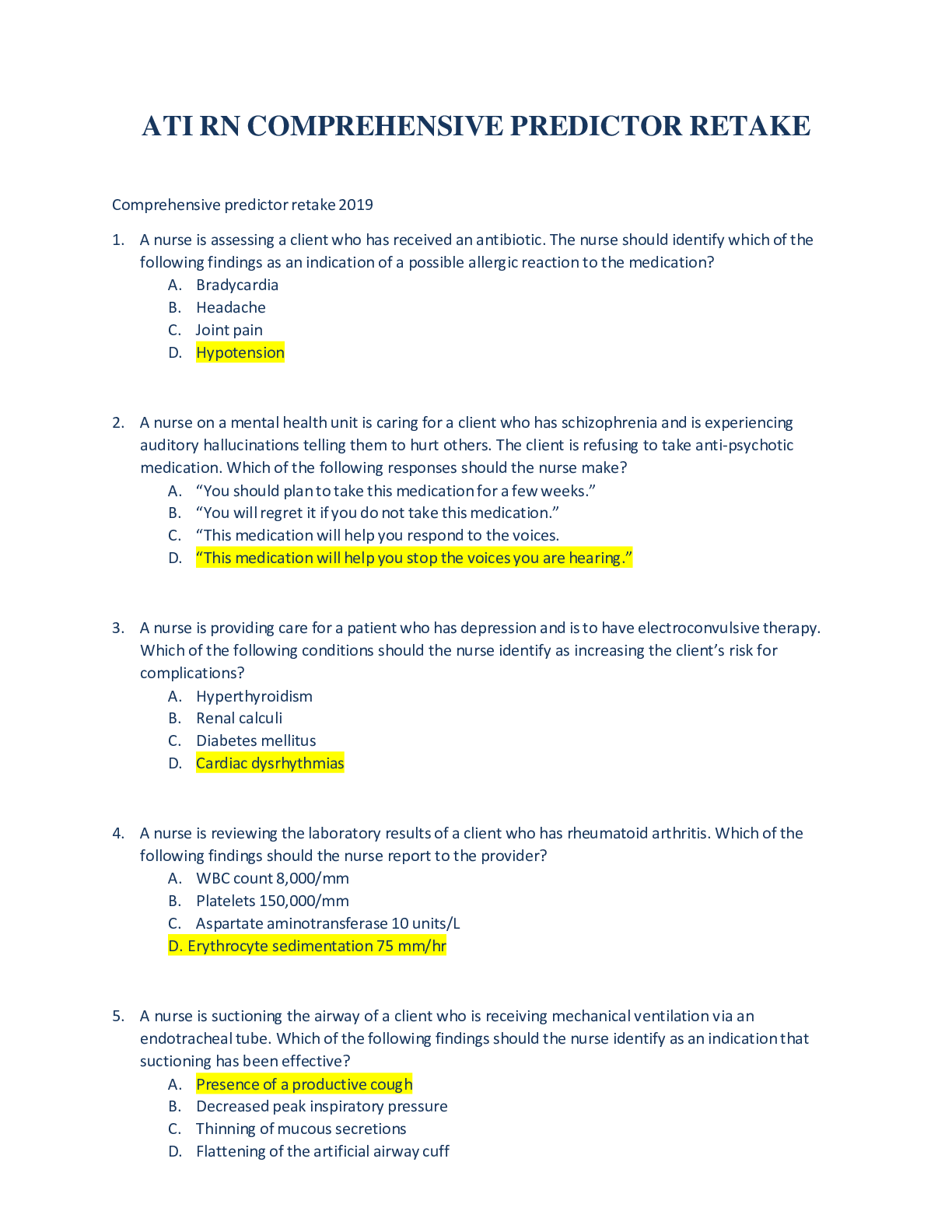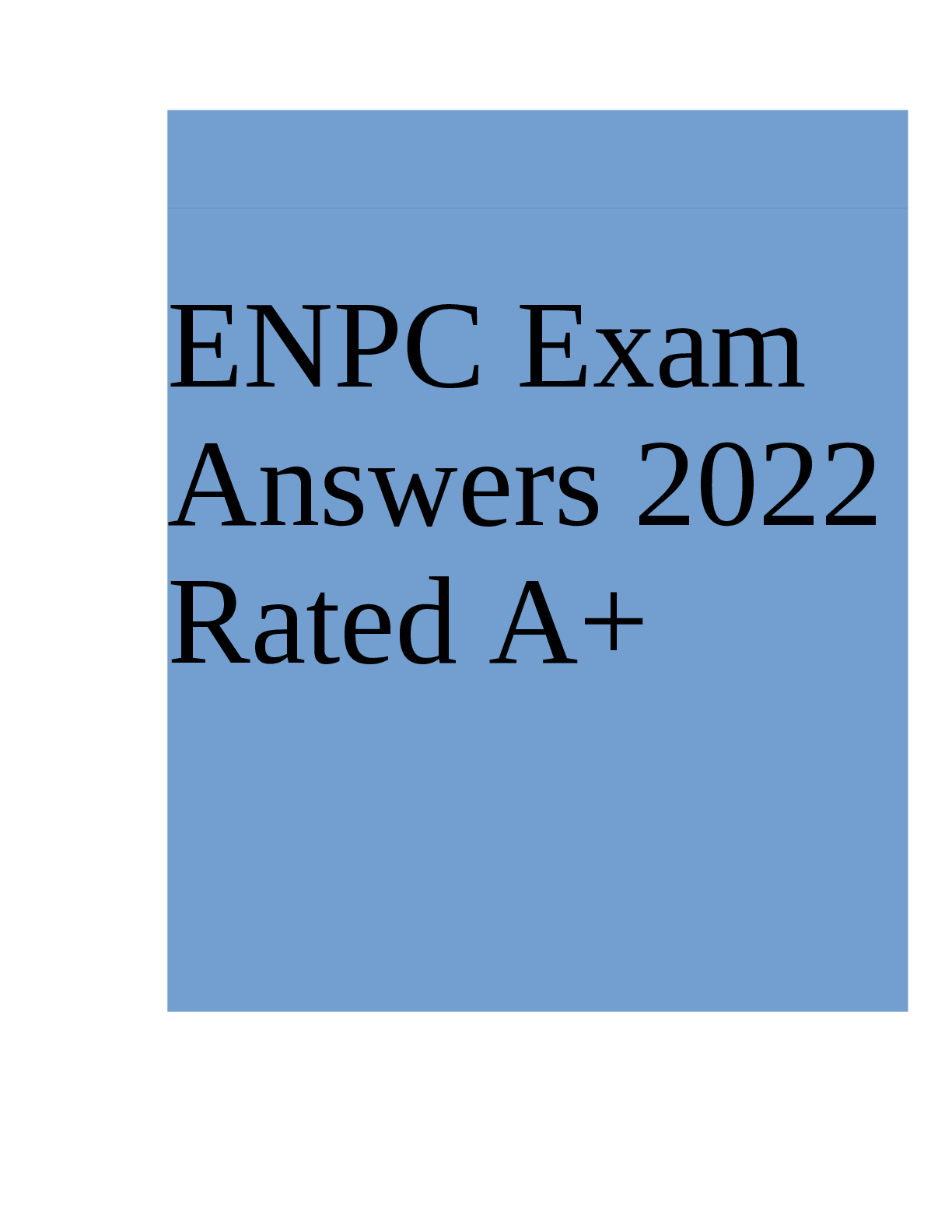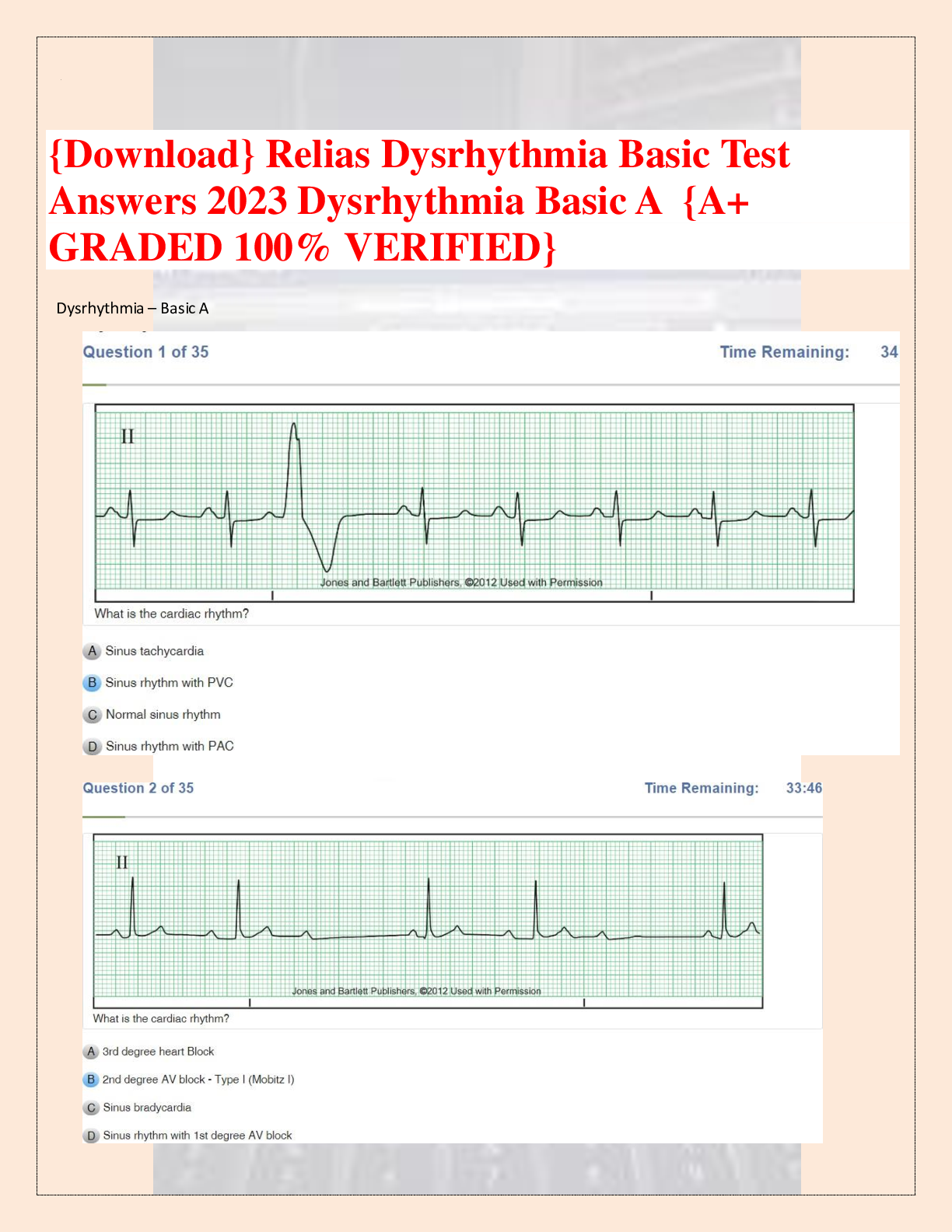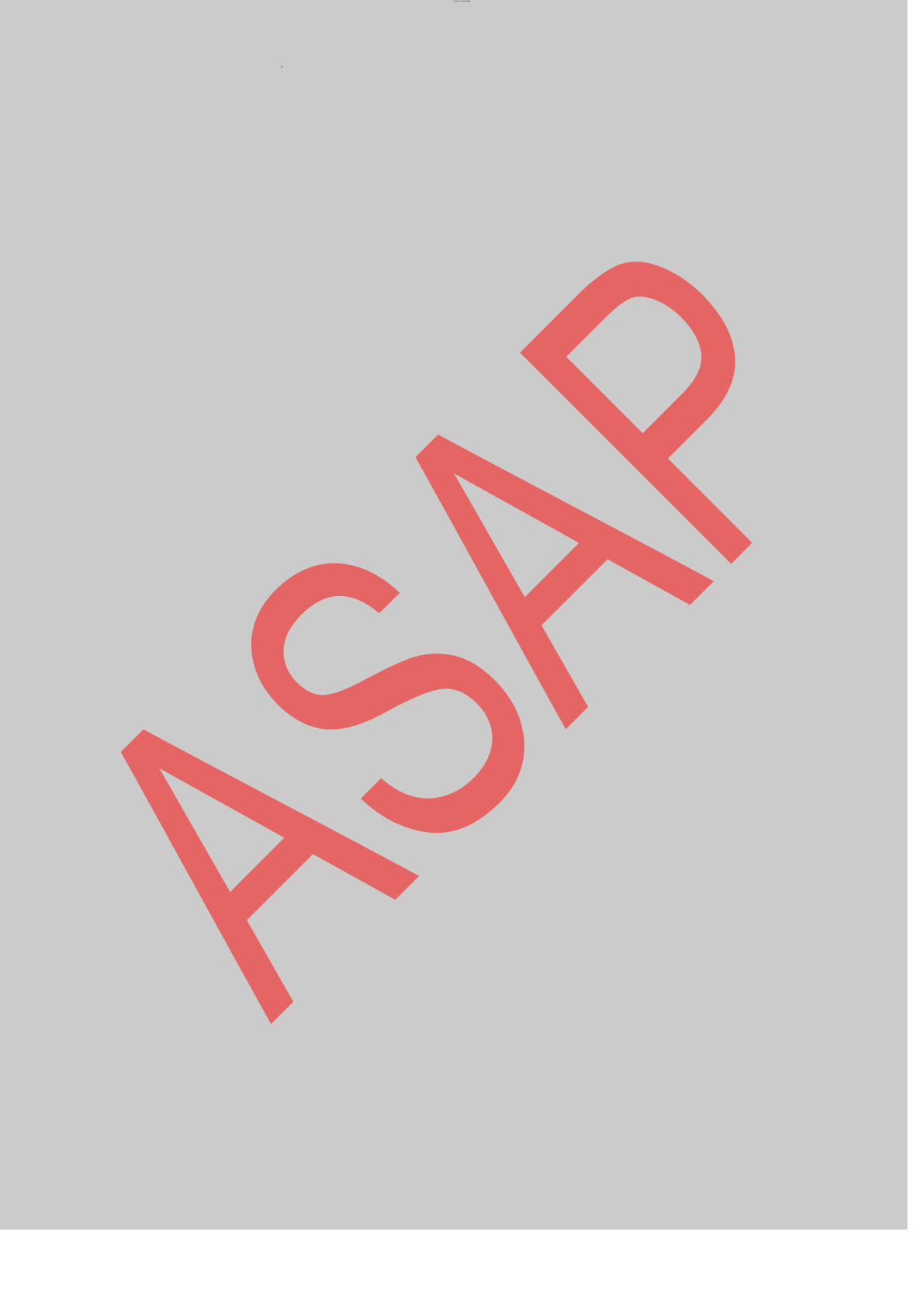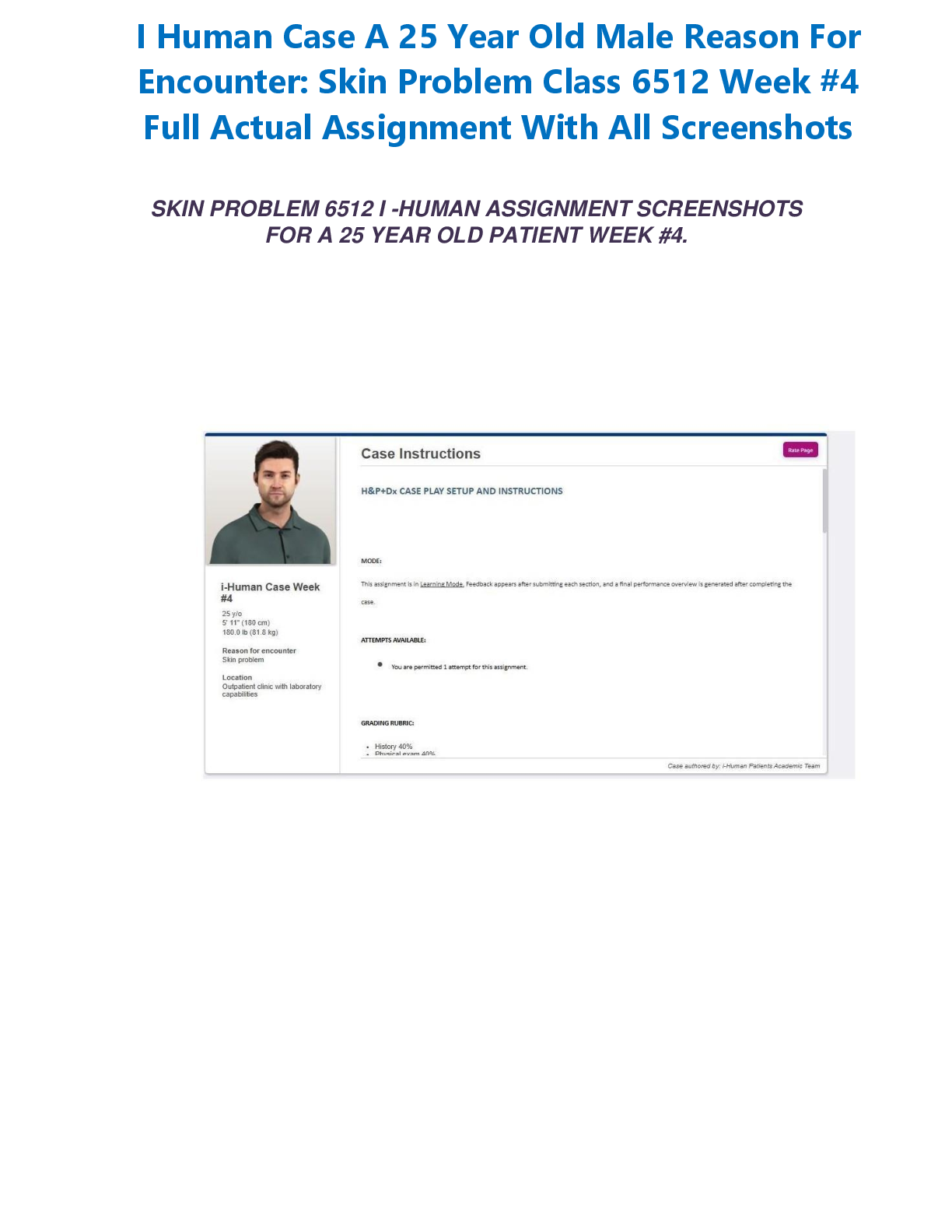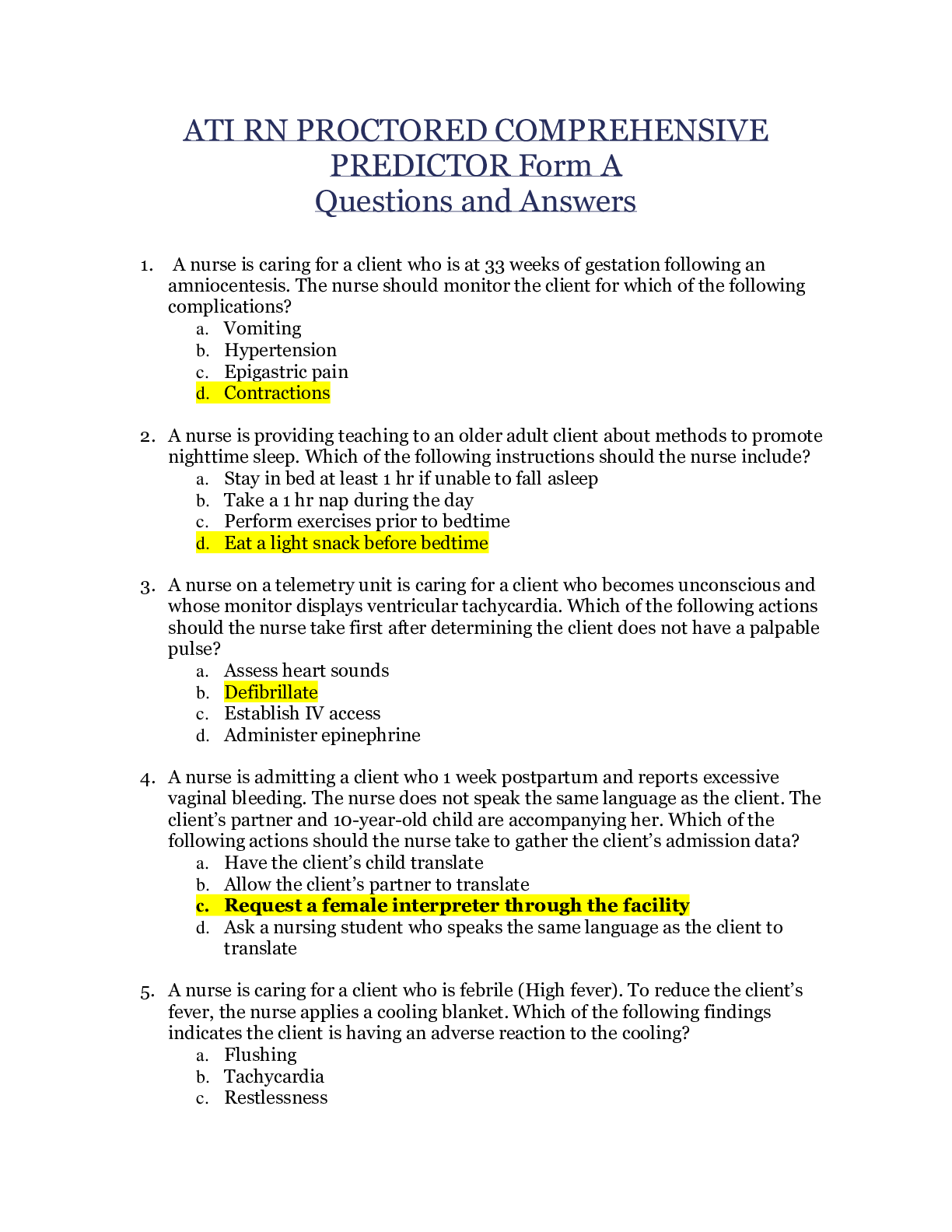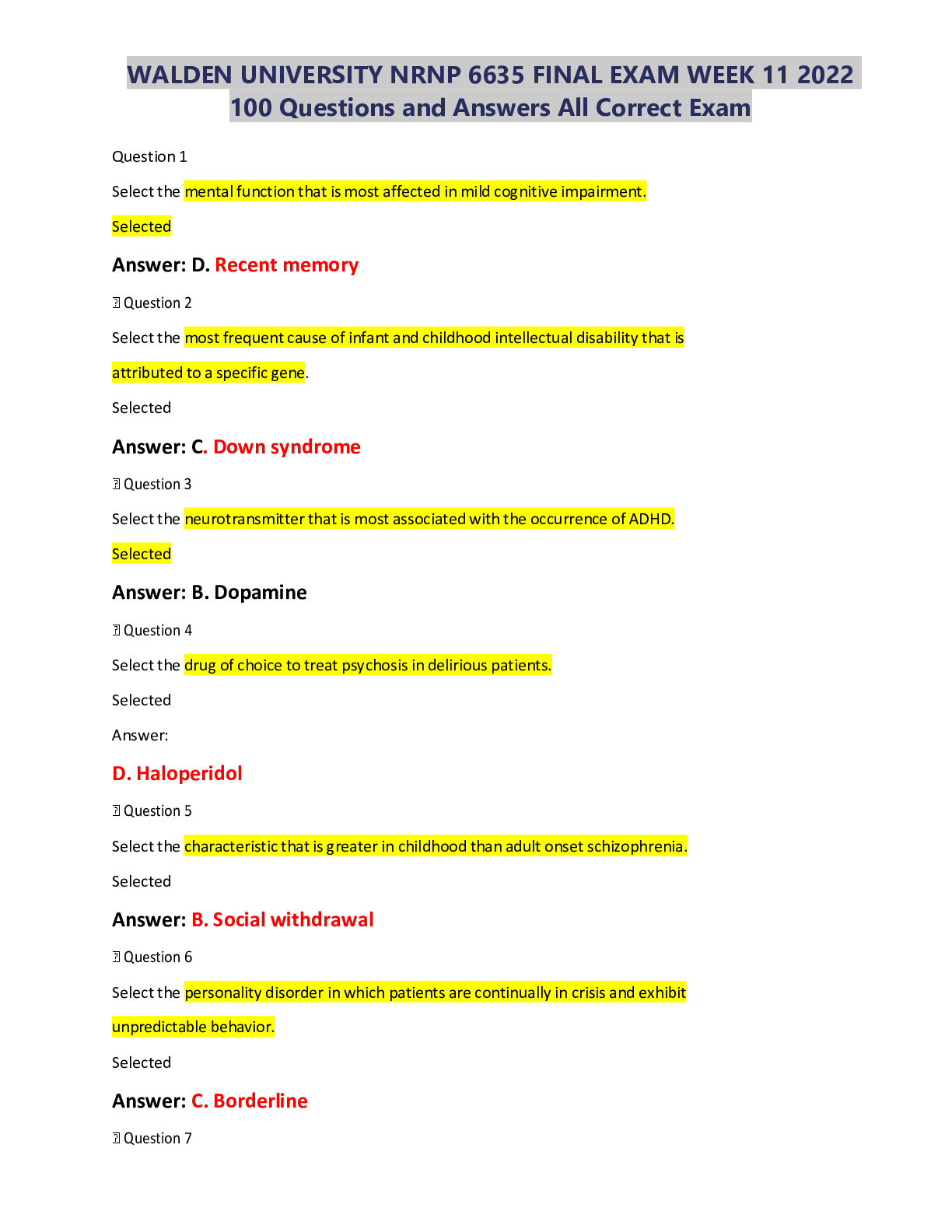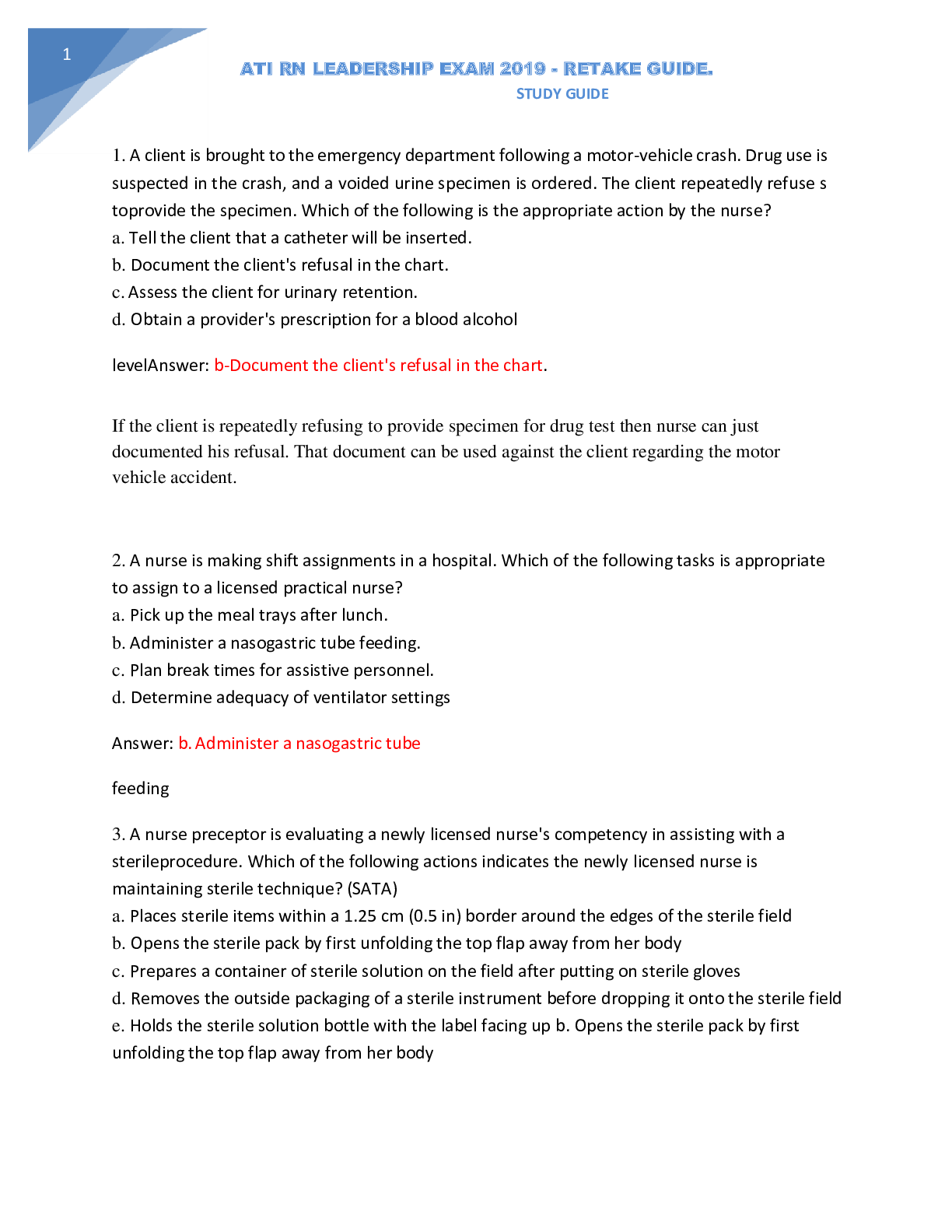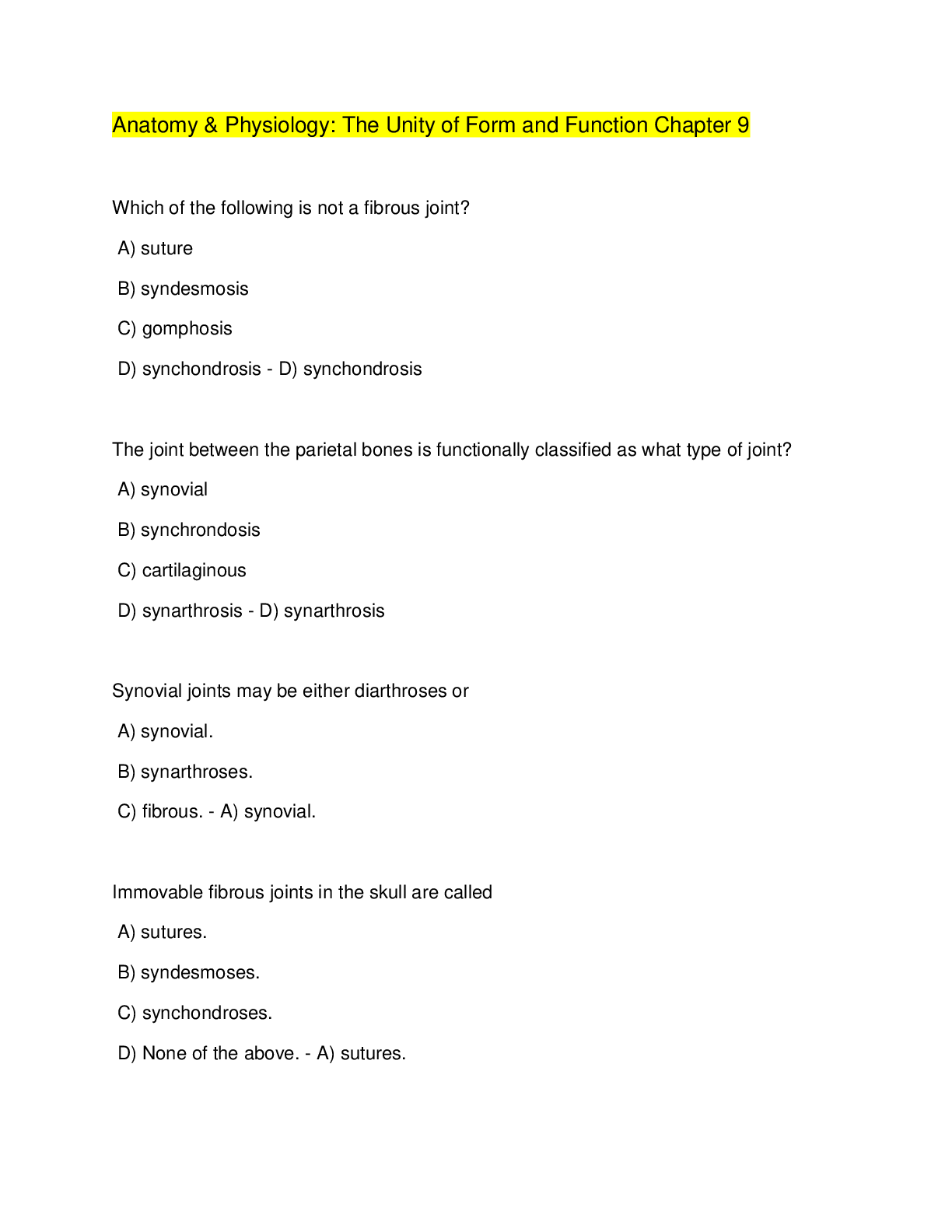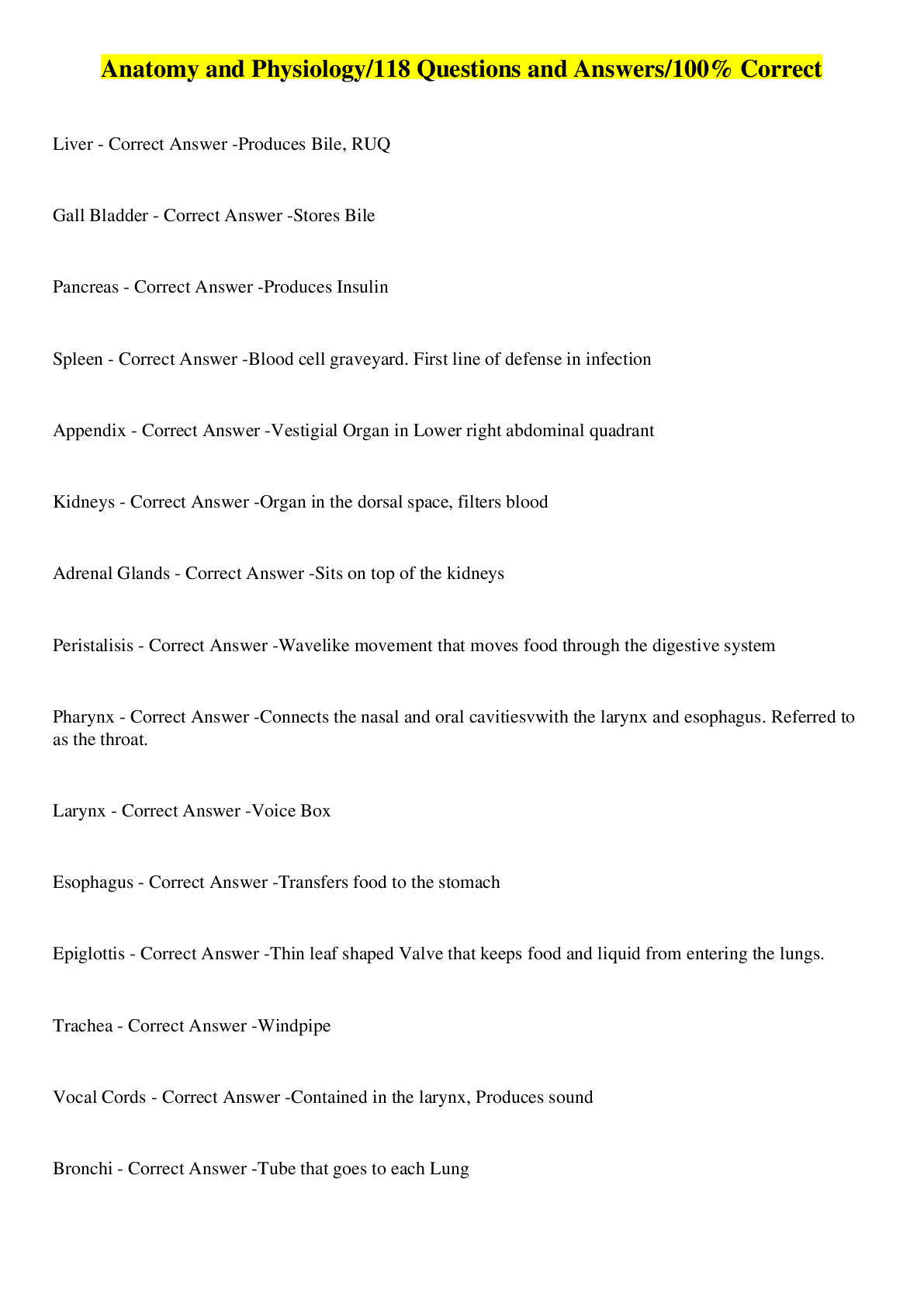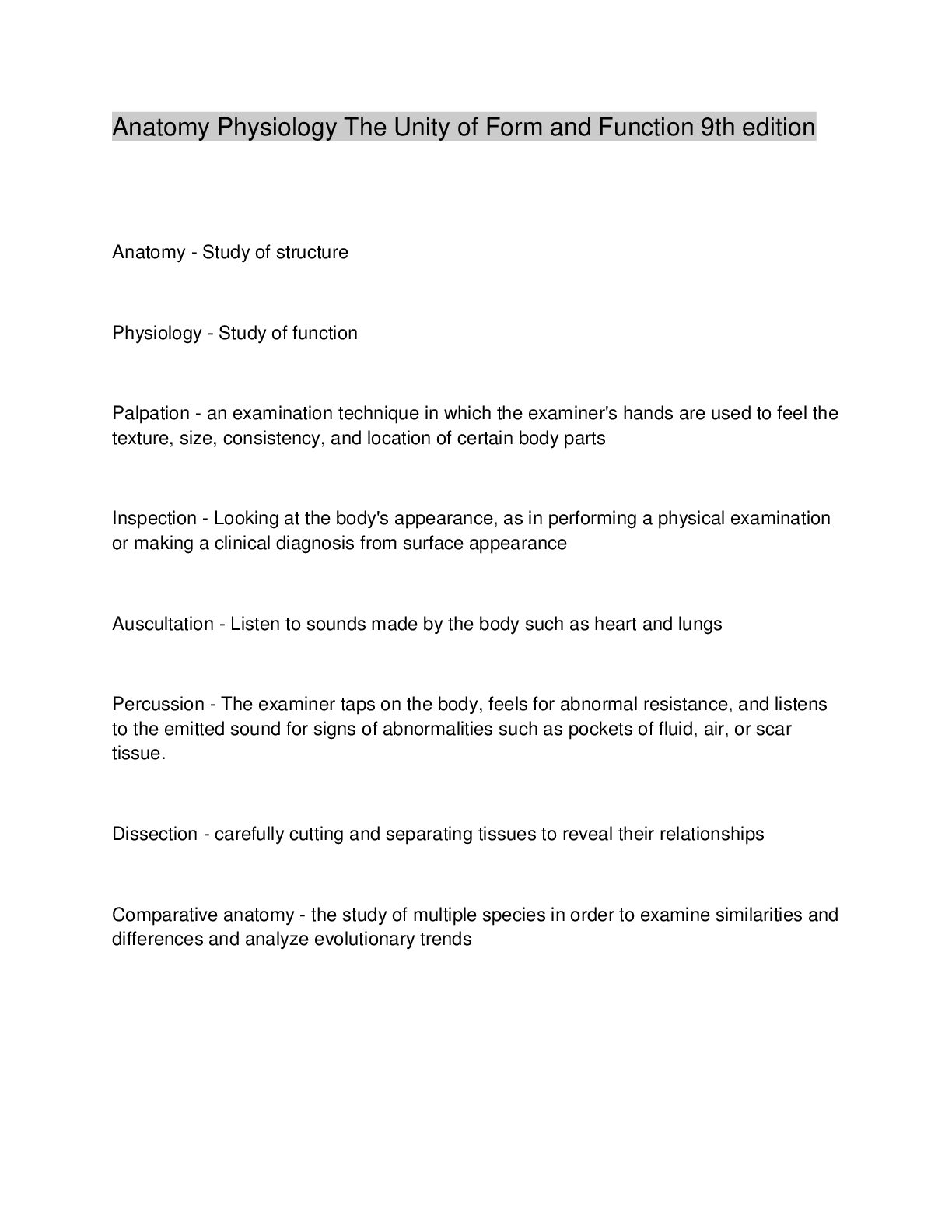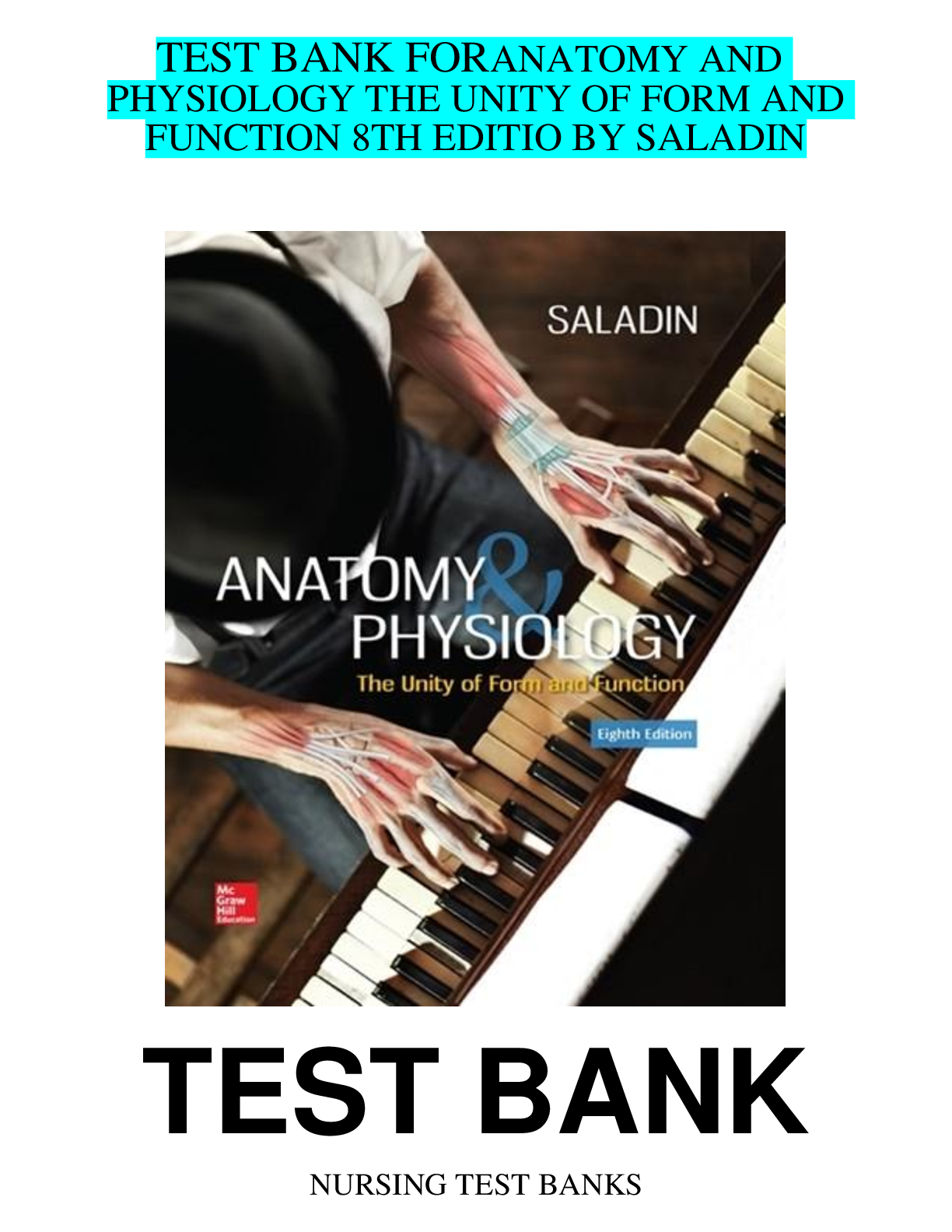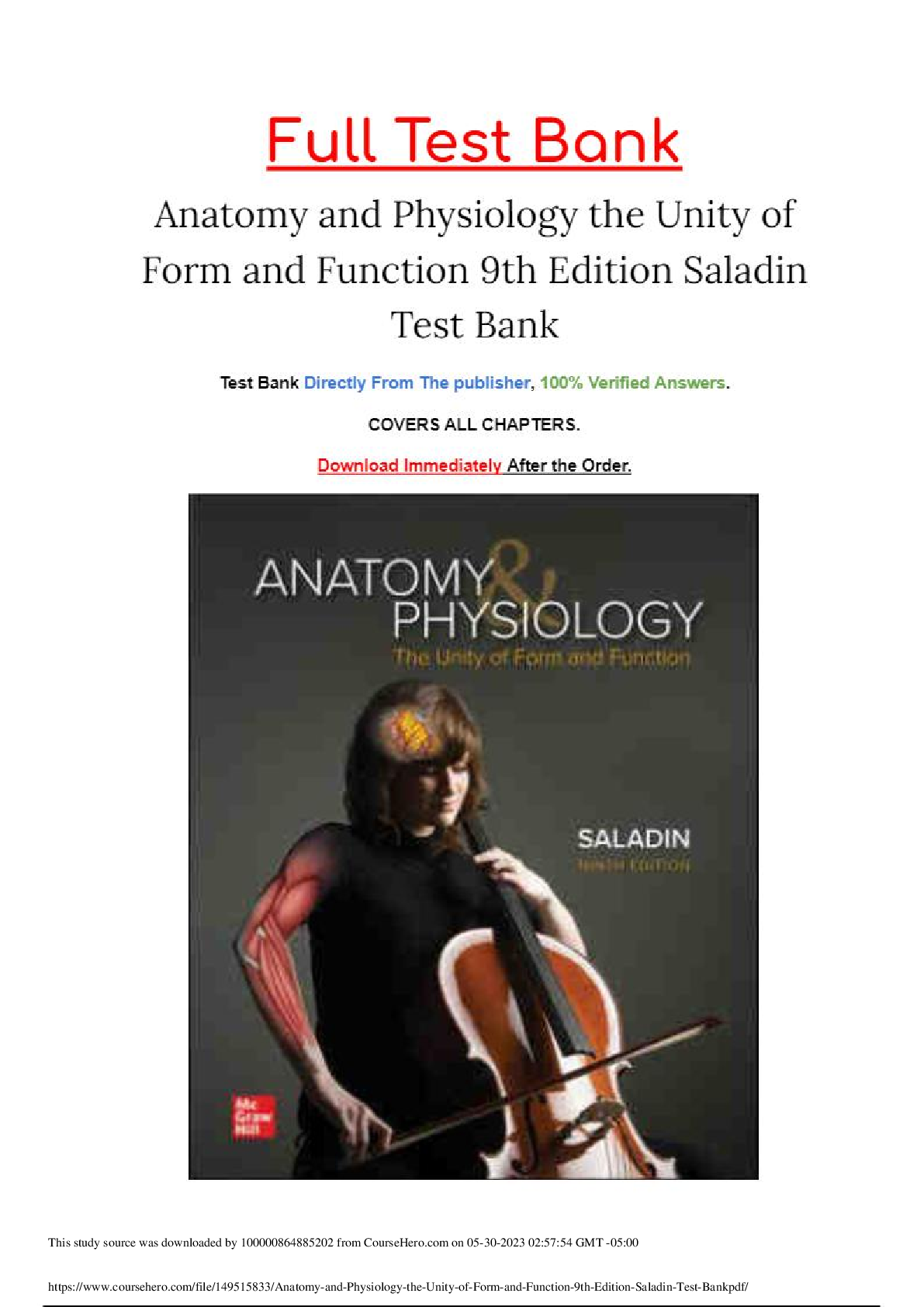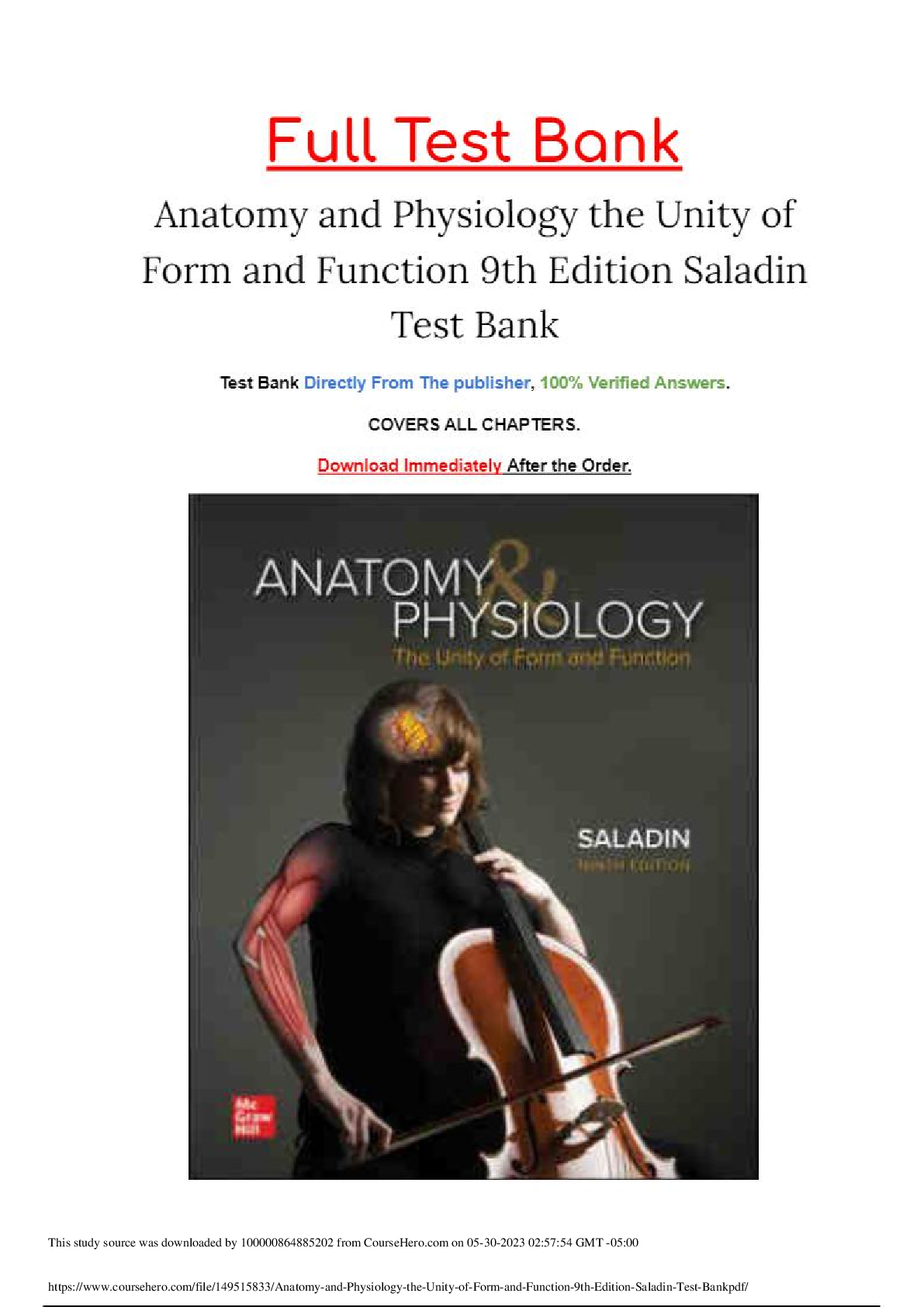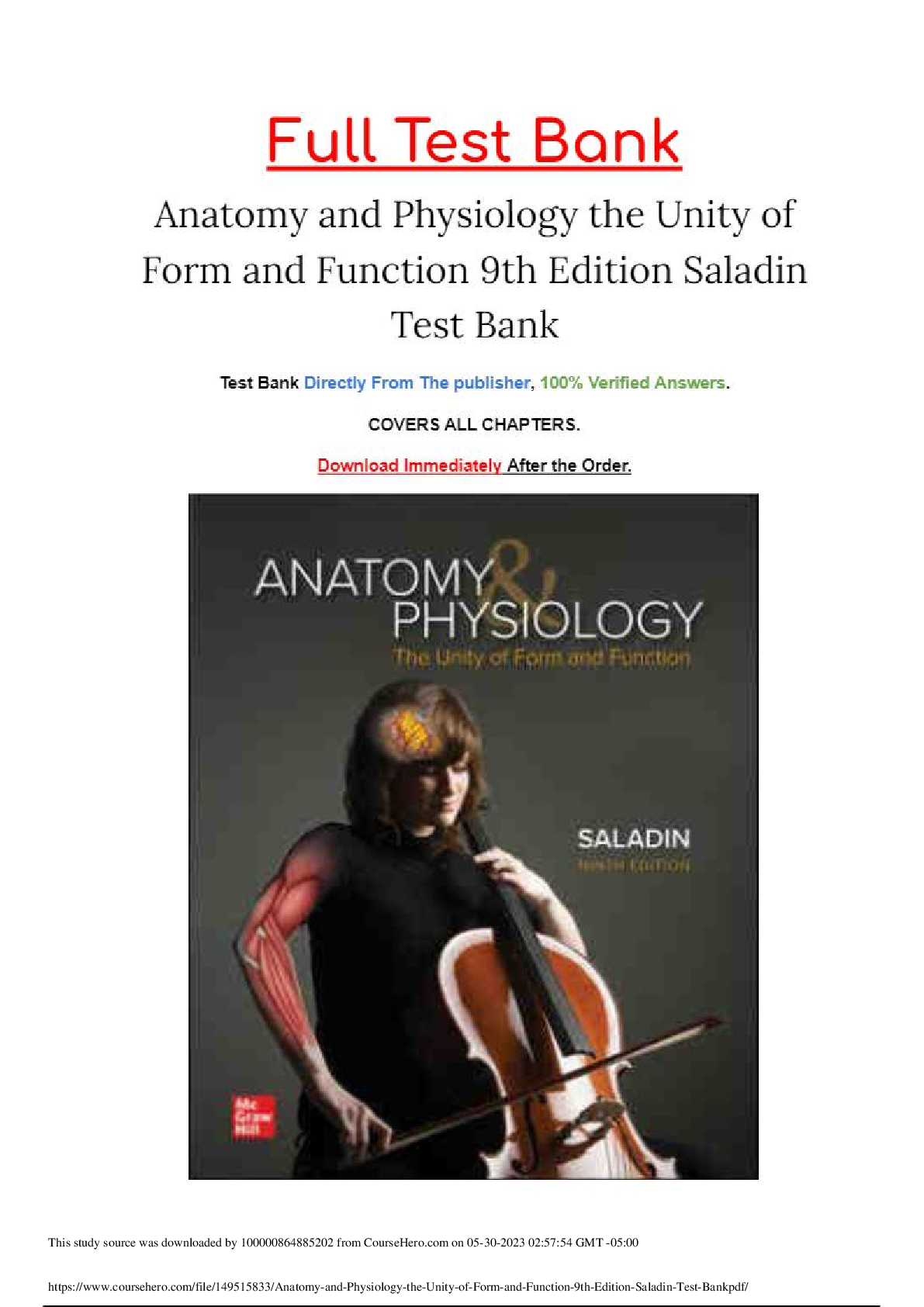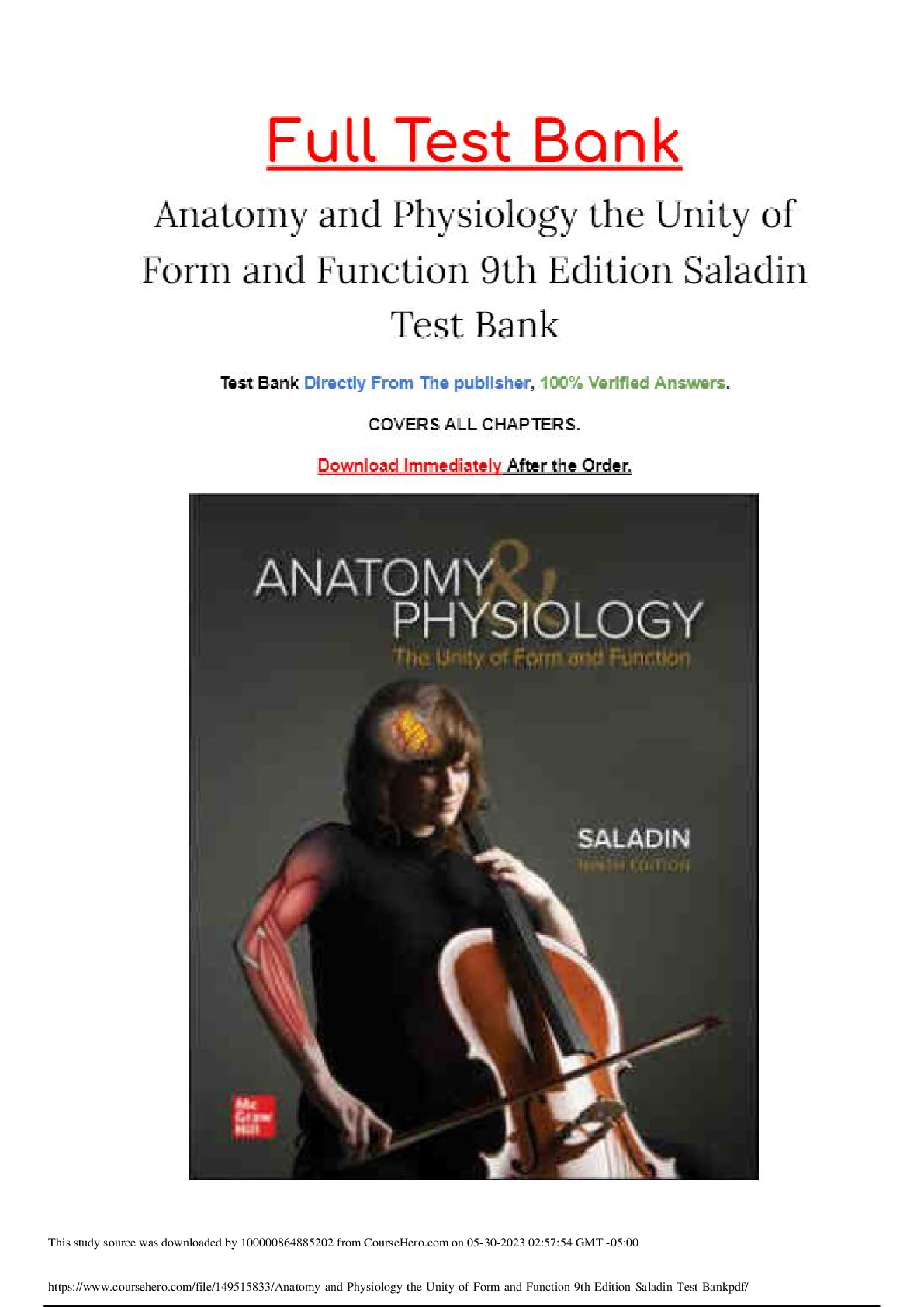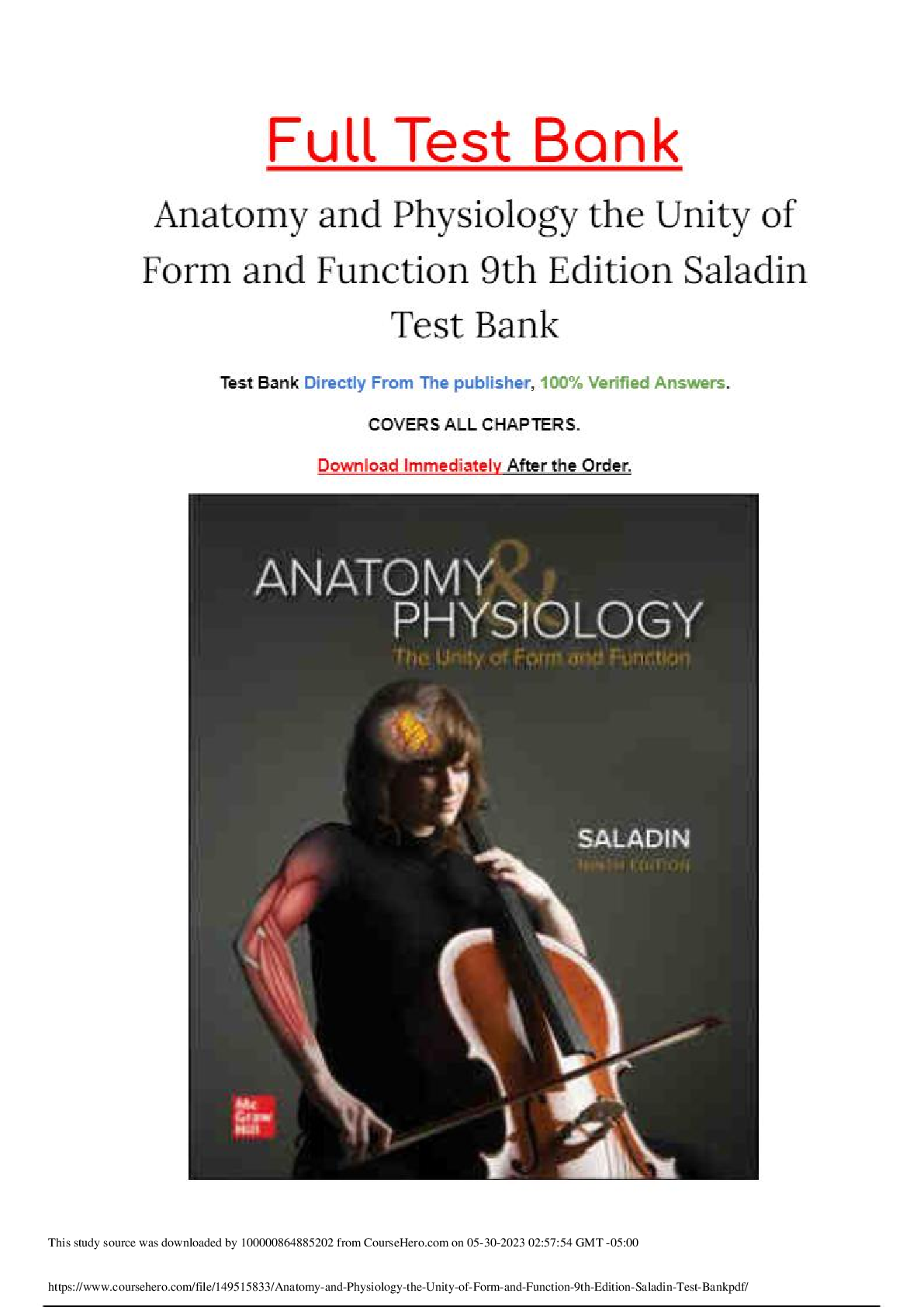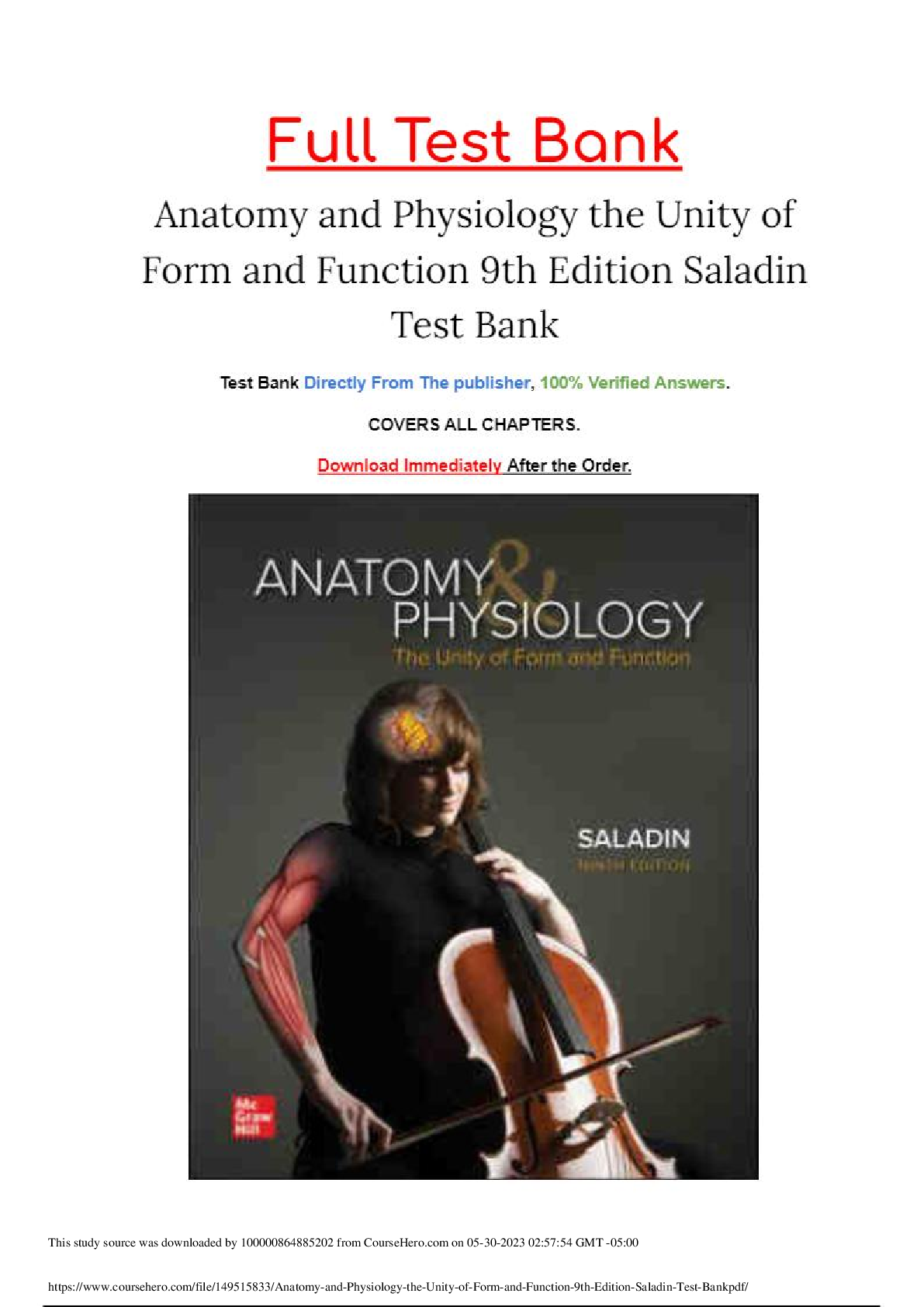Health Care > EXAM > TEST BANK FORANATOMY AND PHYSIOLOGY THE UNITY OF FORM AND FUNCTION 8TH EDITIO BY SALADIN (All)
TEST BANK FORANATOMY AND PHYSIOLOGY THE UNITY OF FORM AND FUNCTION 8TH EDITIO BY SALADIN
Document Content and Description Below
TEST BANK FORANATOMY AND PHYSIOLOGY THE UNITY OF FORM AND FUNCTION 8TH EDITIO BY SALADIN TEST BANK FORANATOMY AND PHYSIOLOGY THE UNITY OF FORM AND FUNCTION 8TH EDITIO BY SALADIN TEST BANK NURSI... NG TEST BANKS NURSINGTB.COM Chapter 02 The Chemistry of Life Answer Key True / False Questions 1. Minerals are organic elements extracted from the soil by plants. FALSE Accessibility: Keyboard Navigation Blooms Level: 1. Remember Gradable: automatic HAPS Objective: O01.01e List the important dietary minerals and describe the major uses of each mineral in the body. HAPS Topic: Module O01 Nutrition. Learning Outcome: 02.01c State the functions of minerals in the body. Section: 02.01 Topic: Atoms and molecules 2. Molecules composed of two or more atoms are called compounds. FALSE Accessibility: Keyboard Navigation Blooms Level: 3. Apply Gradable: automatic HAPS Objective: C01.03 Compare and contrast the terms atoms, molecules, elements, and compounds. HAPS Topic: Module C01 Atoms and molecules. Learning Outcome: 02.01b Distinguish between elements and compounds. NURSINGTB.COM 3. Hydrogen, deuterium, and tritium are three isotopes of hydrogen. TRUE Section: 02.01 Topic: Atoms and molecules Accessibility: Keyboard Navigation Blooms Level: 1. Remember Gradable: automatic HAPS Objective: C01.01c Explain how ions and isotopes are produced by changing the relative number of specific subatomic particles with respect to the structure of an atom. HAPS Topic: Module C01 Atoms and molecules. Learning Outcome: 02.01d Explain the basis for radioactivity and the types and hazards of ionizing radiation. Section: 02.01 Topic: Atoms and molecules 4. Potassium, sodium, and chlorine are trace elements. FALSE Accessibility: Keyboard Navigation Blooms Level: 1. Remember Gradable: automatic HAPS Objective: C01.03 Compare and contrast the terms atoms, molecules, elements, and compounds. HAPS Topic: Module C01 Atoms and molecules. Learning Outcome: 02.01b Distinguish between elements and compounds. Section: 02.01 Topic: Atoms and molecules NURSINGTB.COM 5. Ionic bonds break apart in water more easily than covalent bonds do. TRUE Accessibility: Keyboard Navigation Blooms Level: 2. Understand Gradable: automatic HAPS Objective: C02.01a List each type of bond in order by relative strength with respect to non-polar covalent, polar covalent, ionic, and hydrogen bonds. HAPS Topic: Module C02 Chemical bonding. Learning Outcome: 02.01f Define the types of chemical bonds. Section: 02.01 Topic: Chemical bonding 6. A solution is a mixture of two or more substances that are physically blended but not chemically combined. TRUE Accessibility: Keyboard Navigation Blooms Level: 2. Understand Gradable: automatic HAPS Objective: C03.02 Distinguish among the terms solution, solute, solvent, colloid suspension, and emulsion. HAPS Topic: Module C03 Inorganic compounds and solutions. Learning Outcome: 02.02c Show how three kinds of mixtures differ from each other. Section: 02.02 Topic: Inorganic compounds and solutions 7. The pH of blood plasma is approximately 7.4, which is slightly acidic. FALSE NURSINGTB.COM Accessibility: Keyboard Navigation Blooms Level: 1. Remember Gradable: automatic HAPS Objective: C03.05 State acidic, neutral, and alkaline pH values. HAPS Topic: Module C03 Inorganic compounds and solutions. Learning Outcome: 02.02d Define acid and base and interpret the pH scale. Section: 02.02 Topic: Inorganic compounds and solutions 8. The high heat capacity of water makes it a very ineffective coolant. FALSE Accessibility: Keyboard Navigation Blooms Level: 2. Understand Gradable: automatic HAPS Objective: C03.01 Discuss the physiologically important properties of water. HAPS Topic: Module C03 Inorganic compounds and solutions. Learning Outcome: 02.02b Describe the biologically important properties of water. Section: 02.02 Topic: Inorganic compounds and solutions 9. In an exchange reaction, covalent bonds are broken and new covalent bonds are formed. TRUE Accessibility: Keyboard Navigation Blooms Level: 2. Understand Gradable: automatic HAPS Objective: C04.03 Define and give examples of dehydration synthesis and hydrolysis reactions. HAPS Topic: Module C04 Organic compounds. Learning Outcome: 02.03c List and define the fundamental types of chemicalreactions. Section: 02.03 TEST BANK FORANATOMY AND PHYSIOLOGY THE UNITY OF FORM AND FUNCTION 8TH EDITIO BY SALADIN TEST BANK NURSING TEST BANKS NURSINGTB.COM Chapter 02 The Chemistry of Life Answer Key True / False Questions 1. Minerals are organic elements extracted from the soil by plants. FALSE Accessibility: Keyboard Navigation Blooms Level: 1. Remember Gradable: automatic HAPS Objective: O01.01e List the important dietary minerals and describe the major uses of each mineral in the body. HAPS Topic: Module O01 Nutrition. Learning Outcome: 02.01c State the functions of minerals in the body. Section: 02.01 Topic: Atoms and molecules 2. Molecules composed of two or more atoms are called compounds. FALSE Accessibility: Keyboard Navigation Blooms Level: 3. Apply Gradable: automatic HAPS Objective: C01.03 Compare and contrast the terms atoms, molecules, elements, and compounds. HAPS Topic: Module C01 Atoms and molecules. Learning Outcome: 02.01b Distinguish between elements and compounds. NURSINGTB.COM 3. Hydrogen, deuterium, and tritium are three isotopes of hydrogen. TRUE Section: 02.01 Topic: Atoms and molecules Accessibility: Keyboard Navigation Blooms Level: 1. Remember Gradable: automatic HAPS Objective: C01.01c Explain how ions and isotopes are produced by changing the relative number of specific subatomic particles with respect to the structure of an atom. HAPS Topic: Module C01 Atoms and molecules. Learning Outcome: 02.01d Explain the basis for radioactivity and the types and hazards of ionizing radiation. Section: 02.01 Topic: Atoms and molecules 4. Potassium, sodium, and chlorine are trace elements. FALSE Accessibility: Keyboard Navigation Blooms Level: 1. Remember Gradable: automatic HAPS Objective: C01.03 Compare and contrast the terms atoms, molecules, elements, and compounds. HAPS Topic: Module C01 Atoms and molecules. Learning Outcome: 02.01b Distinguish between elements and compounds. Section: 02.01 Topic: Atoms and molecules NURSINGTB.COM 5. Ionic bonds break apart in water more easily than covalent bonds do. TRUE Accessibility: Keyboard Navigation Blooms Level: 2. Understand Gradable: automatic HAPS Objective: C02.01a List each type of bond in order by relative strength with respect to non-polar covalent, polar covalent, ionic, and hydrogen bonds. HAPS Topic: Module C02 Chemical bonding. Learning Outcome: 02.01f Define the types of chemical bonds. Section: 02.01 Topic: Chemical bonding 6. A solution is a mixture of two or more substances that are physically blended but not chemically combined. TRUE Accessibility: Keyboard Navigation Blooms Level: 2. Understand Gradable: automatic HAPS Objective: C03.02 Distinguish among the terms solution, solute, solvent, colloid suspension, and emulsion. HAPS Topic: Module C03 Inorganic compounds and solutions. Learning Outcome: 02.02c Show how three kinds of mixtures differ from each other. Section: 02.02 Topic: Inorganic compounds and solutions 7. The pH of blood plasma is approximately 7.4, which is slightly acidic. FALSE NURSINGTB.COM Accessibility: Keyboard Navigation Blooms Level: 1. Remember Gradable: automatic HAPS Objective: C03.05 State acidic, neutral, and alkaline pH values. HAPS Topic: Module C03 Inorganic compounds and solutions. Learning Outcome: 02.02d Define acid and base and interpret the pH scale. Section: 02.02 Topic: Inorganic compounds and solutions 8. The high heat capacity of water makes it a very ineffective coolant. FALSE Accessibility: Keyboard Navigation Blooms Level: 2. Understand Gradable: automatic HAPS Objective: C03.01 Discuss the physiologically important properties of water. HAPS Topic: Module C03 Inorganic compounds and solutions. Learning Outcome: 02.02b Describe the biologically important properties of water. Section: 02.02 Topic: Inorganic compounds and solutions 9. In an exchange reaction, covalent bonds are broken and new covalent bonds are formed. TRUE Accessibility: Keyboard Navigation Blooms Level: 2. Understand Gradable: automatic HAPS Objective: C04.03 Define and give examples of dehydration synthesis and hydrolysis reactions. HAPS Topic: Module C04 Organic compounds. Learning Outcome: 02.03c List and define the fundamental types of chemicalreactions. Section: 02.03 [Show More]
Last updated: 2 years ago
Preview 1 out of 25 pages

Buy this document to get the full access instantly
Instant Download Access after purchase
Buy NowInstant download
We Accept:

Reviews( 0 )
$15.00
Can't find what you want? Try our AI powered Search
Document information
Connected school, study & course
About the document
Uploaded On
Apr 22, 2023
Number of pages
25
Written in
Additional information
This document has been written for:
Uploaded
Apr 22, 2023
Downloads
0
Views
68

